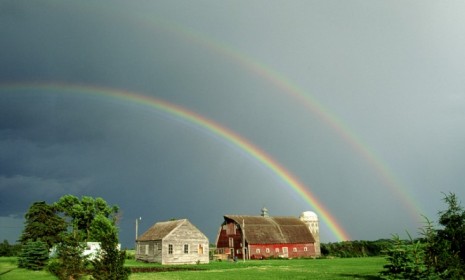Is the elusive 'triple rainbow' scientifically possible?
Once dismissed as hoaxes, triple and even quadruple rainbows are now being taken seriously. Here's how you can spot one yourself

Remember the over-the-top, borderline-insane glee of "double rainbow guy"? Well, imagine how excited he'd be if he saw a triple rainbow. Only five tertiary rainbows — the scientific term for three rainbows arcing through the sky at once — have been spotted in the last 250 years; others have been dismissed by the scientific community as hoaxes. But now, using new findings published in the Optical Society's journal Applied Optics as their guide, scientists are embarking on a treasure hunt for the elusive phenomenon. Who are these rainbow chasers? Here's what you should know:
First off, how do rainbows work?
When sunlight hits raindrops at a relatively low angle, the colors within the light bend and reflect at different angles — separating the colors and creating the optical effect of a rainbow. A double rainbow occurs when not all of that light exits the drop, and is instead reflected back into the raindrop to go through the process again. As a result, double rainbows are dimmer, because the amount of original light is split and diminished in the re-reflecting process. That same principle applies to tertiary rainbows, which are even dimmer and more difficult to see.
The Week
Escape your echo chamber. Get the facts behind the news, plus analysis from multiple perspectives.

Sign up for The Week's Free Newsletters
From our morning news briefing to a weekly Good News Newsletter, get the best of The Week delivered directly to your inbox.
From our morning news briefing to a weekly Good News Newsletter, get the best of The Week delivered directly to your inbox.
Why the renewed interest in triple rainbows?
Credit the U.S. Naval Academy's Raymond Lee. At a recent meteorological conference, he presented a computer model explaining the conditions in which triple rainbows are most likely to be seen: "Dark thunderclouds and a heavy downpour with uniformly sized droplets," says Duncan Geere at Wired. "In these conditions, if the sun breaks through the clouds, a tertiary rainbow can be created that's visible." Lee challenged the attendees to go out and find triple rainbows, and photographer Michael Thusner eventually caught one on camera.
And this photo is real?
It seems like it. And if it is, the photo corroborates Lee's claim that not only are triple rainbows possible, but quadruple (or quaternary) rainbows could theoretically be seen, too. What's the best way to lay your eyes on these "incredibly rare" lightshows? Geere says, "Next time you're in a storm and a double rainbow appears, turn around and look towards the sun."
A free daily email with the biggest news stories of the day – and the best features from TheWeek.com
Sources: Science Daily, Wired, io9
-
 Can Mike Johnson keep his job?
Can Mike Johnson keep his job?Today's Big Question GOP women come after the House leader
-
 A postapocalyptic trip to Sin City, a peek inside Taylor Swift’s “Eras” tour, and an explicit hockey romance in December TV
A postapocalyptic trip to Sin City, a peek inside Taylor Swift’s “Eras” tour, and an explicit hockey romance in December TVthe week recommends This month’s new television releases include ‘Fallout,’ ‘Taylor Swift: The End Of An Era’ and ‘Heated Rivalry’
-
 ‘These accounts clearly are designed as a capitalist alternative’
‘These accounts clearly are designed as a capitalist alternative’Instant Opinion Opinion, comment and editorials of the day